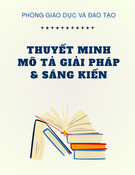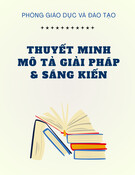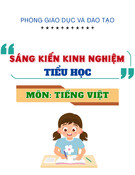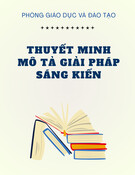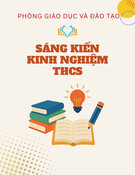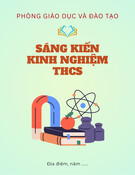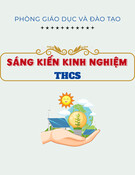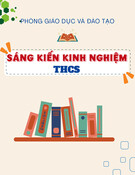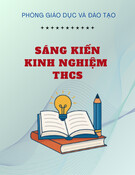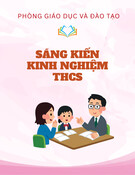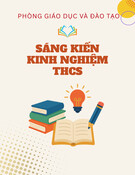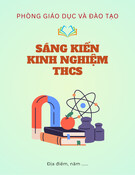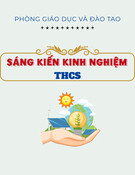
1
TRƯỜNG THPT NGUYỄN HỮU CẢNH
Mã số: ................................
SÁNG KIẾN
THE EFFECT OF USING MIND-MAPPING TECHNIQUE ON ENHANCING
NGUYEN HUU CANH HIGH SCHOOL STUDENTS’ READING SKILLS
Người thực hiện: Nguyen Phan Van Anh
Lĩnh vực nghiên cứu:
- Quản lý giáo dục
- Phương pháp giáo dục
- Phương pháp dạy học bộ môn: Tiếng Anh ☒
- Lĩnh vực khác: .......................................................
Có đính kèm:
Mô hình Đĩa CD (DVD) Phim ảnh Hiện vật khác
Năm học:2019-2020
Ngườ ự ện: …………………………........................
Lĩnh vự ứ
ả ụ

2
TRƯỜNG THPT NGUYỄN HỮU CẢNH
Mã số: ................................
SÁNG KIẾN
THE EFFECT OF USING MIND-MAPPING TECHNIQUE ON
ENHANCING NGUYEN HUU CANH HIGH SCHOOL STUDENTS’
READING SKILLS
Người thực hiện: Nguyen Phan Van Anh
Lĩnh vực nghiên cứu:
- Quản lý giáo dục
- Phương pháp giáo dục
- Phương pháp dạy học bộ môn: Tiếng Anh ☒
- Lĩnh vực khác: .......................................................
Có đính kèm:
Mô hình Đĩa CD (DVD) Phim ảnh Hiện vật khác
Năm học:2019-2020

3
CONTENTS
1. Introduction 5
2. Literature review 6
2.1. Definitions of mind-mapping 6
2.2. Characteristics of mind-mapping 6
3. Methodology 7
3.1. Research context 7
3.2. Participants 7
3.3. Research instruments 7
4. Some basic types of mind maps 8
5. Stages of using mind map in teaching reading 11
6. Results 13
7. Discussion and Recommendation 15
8. Evaluation 16
8.1. The novelty of the research 16
8.2. The effectiveness of using mind-mapping technique on enhancing students’
reading skill 16
8.3. The applicable practices of the research 17
9. Conclusion 18
Appendices 19
References 20

4
THÔNG TIN CHUNG VỀ SÁNG KIẾN
1. Tên sáng kiến: THE EFFECT OF USING MIND-MAPPING TECHNIQUE
ON ENHANCING NGUYEN HUU CANH HIGH SCHOOL
STUDENTS’READING SKILLS
2. Lĩnh vực áp dụng sáng kiến: Ngoại ngữ
3. Tác giả:
- Họ và tên: Nguyễn Phan Vân Anh. Nam (nữ): Nữ
- Trình độ chuyên môn: Cử nhân
- Chức vụ, đơn vị công tác: Giáo viên Tiếng Anh-Trường THPT Nguyễn Hữu Cảnh
- Điện thoại: 0933095858 Email: vananh@nhc.edu.vn
Tỷ lệ đóng góp tạo ra sáng kiến (%): 100%

5
THE EFFECT OF USING MIND-MAPPING TECHNIQUE ON
ENHANCING NGUYEN HUU CANH HIGH SCHOOL STUDENTS’
READING SKILLS
1. INTRODUCTION
According to Barnett (1989), reading comprehension is considered as an essential
part of the teaching and learning process in second language acquisition. Not only
does it serve the important purposes in after the students’ completion language study
at school, it also promotes the literacy skills later. Moreover, the ability to analyze
and interpret written materials is an integral element of success at tertiary level
(Ntereke & Ramoroka, 2017). Nevertheless, in high school’s context, study about
reading comprehension suggests most students find it hard when dealing with
reading texts. They almost do not understand the texts and cannot complete the tasks
due to their ineffective and inefficient strategies (Wood, et al., 1998). L2 research
also shows that one effective comprehension strategy is the use of mind-mapping
(Liu, Chen & Chang, 2010). Generalizing the main ideas of the reading passage and
vocabulary acquisition are somehow struggling for high school students. Teachers,
conventionally, ask students to highlight new vocabulary and they will explain the
meaning of the words, make students learn by heart. The students have to memorize
new words immediately and follow the reading text, simultaneously. Therefore, I
have thought of a new way to help students to not only memorize new words in
context but have a thorough understanding of the reading text.
This study investigated whether mind-map is an effective learning tool to Nguyen
Huu Canh High school students’ reading skills and their perception towards the use
of mind-map.
Research objectives
The study is conducted to examine the effectiveness of mind-mapping on Nguyen
Huu Canh High school students (Grade 12)’ reading skills, following are the two
research questions:

